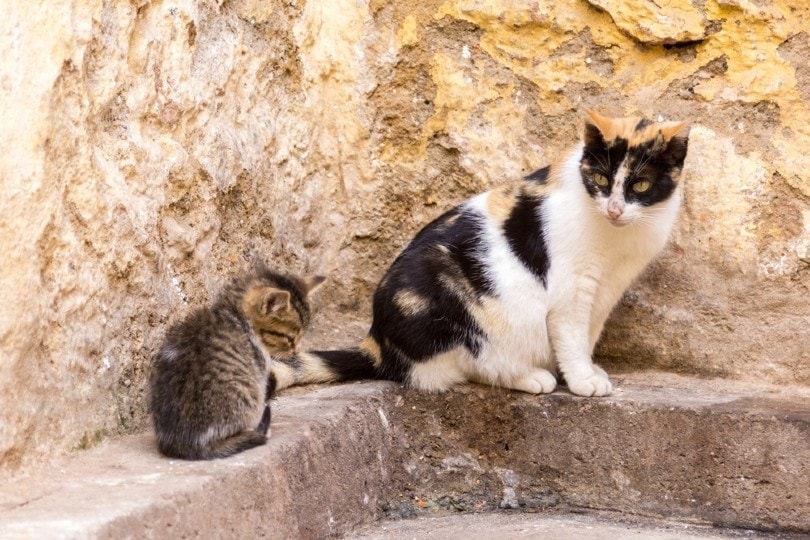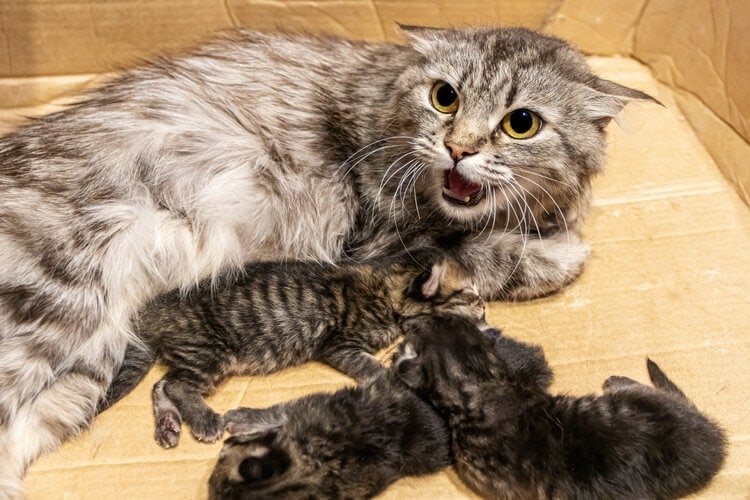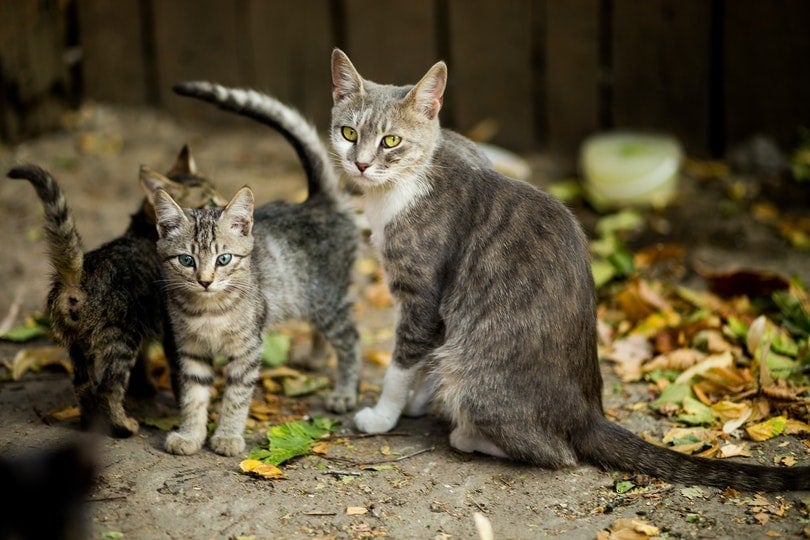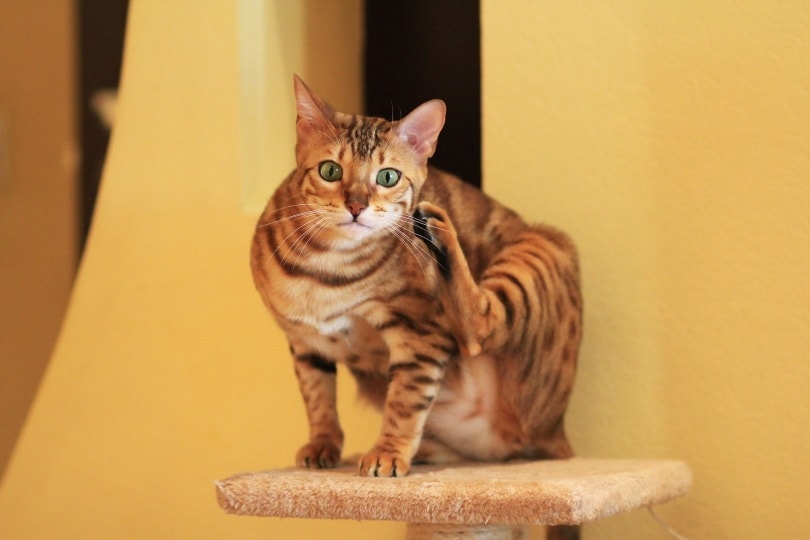How to Tell if a Mother Cat has Abandoned Her Kittens: 6 Steps
Updated on

There is a lot of misunderstanding surrounding how cats and other mammals may react when their kittens are handled or threatened by people or other animals. It can lead to a lot of confusion and may even lead to people unintentionally taking kittens away from their mother, decreasing their chances of survival.
If you’ve come across a litter of kittens or have a mother who doesn’t seem to be very attentive to her kittens’ needs, it’s important to determine if their mother has truly abandoned them before you take them. Here are the things to know about whether a mother cat may have abandoned her kittens.
Reasons a Cat May Abandon Her Kittens
Some mother cats may abandon a single kitten if she senses something is wrong with it. Cats are very perceptive and can instinctually tell when something is wrong with their babies. If a mother cat is refusing to groom or feed, it’s very possible that there is an underlying issue with the kitten that should be addressed. If she has abandoned the whole litter it is more likely that there is an illness of the mother such as mastitis or womb infections.
Some first-time mother cats will abandon their kittens simply because their instincts to mother the kittens haven’t kicked in yet. This tends to happen with very young cats on their first litter of kittens usually under 1 year of age. Considering cats can become pregnant as young as 4 months of age, it’s possible to have a kitten giving birth to kittens and not having a clue what to do with them.
Female cats may also abandon their kittens if they feel they or the kittens are being threatened or there is environmental stress. This isn’t as common in domestic cats that are comfortable with people as it is in feral cats. Feral cats tend to be exceedingly distrustful of humans and are not likely to return to kittens with people hanging around them. They may even give up returning to the kittens, considering the presence of the people to be too great a risk.

The 6 Ways to Tell if a Mother Cat has Abandoned Her Kittens
1. Listen for Cries.
Just like with human babies, kittens have specific mews that mean different things. Kittens that are hungry may become restless and begin mewing for their mother. However, kittens that have not been fed in a while and are becoming desperate for food or warmth may become excessively noisy and desperate-sounding. Their cries may become high-pitched and frantic as time goes on. If the kittens begin behaving this way and then seemingly begin to quiet and fade without the mother returning, you may need to intervene.
If you own the queen, you may put her back with the kittens and pet her while she allows the kittens a chance to feed. If the mother is feral, you may need to take the kittens or feed them kitten formula and return them to the nest.
2. Use Your Eyes.
Start by standing far away from the kittens about 35 feet and keep an eye out for the mother. Some feral cats will not come back if they are aware of any humans near their litter. It is also normal for the queen to be off hunting for a period of a few hours at a time.
If the queen does not seem to be coming back look the kittens over without touching them. Kittens that have been abandoned may be dirty and will not appear groomed. Mother cats help kittens urinate, defecate, and keep them clean, so kittens that have not had help with this may have urine or feces on them or may appear bloated due to constipation and full bladder from not being stimulated to potty.
Look at the environment the kittens are in as well. A mother cat is unlikely to leave her kittens out in the open or on a cold, hard surface unless does not intend to come back. Kittens that have not been abandoned are likely to be comfortable and safe in a warm spot.

3. Lay a Trap.
If you’re not sure if the mother is coming back or not, you can set up some type of “trap” to determine if she is coming when you aren’t there. A sprinkling of flour can be laid around the nest, and you can check it after a few hours to see if there are fresh footprints in the flour that may indicate the mother came by to check on the kittens. Game cameras and other types of motion-detection cameras are also good options for determining if a mother is coming to spend time with her kittens or not.
4. Give Plenty of Space.
If you’ve set some kind of camera or trap to determine if the mother cat is coming back to the kittens, you’ll need to give her plenty of space, especially when dealing with a feral or anxious cat. Otherwise, your presence may deter her from returning. If the mother cat intends to return, she’s likely watching you bother her kittens and nest, and she is unlikely to show herself in the area as long as she knows you’re present and nearby. At a minimum, you should set up at least 35 feet from the kittens while waiting for the mom to return.

5. Evaluate the Area.
If you’re unsure if the kittens have been abandoned, it’s important to evaluate the area they’re located in. Some situations will require your intervention, even if you’re unsure if the kittens have been abandoned. Kittens are at high risk for hypothermia, so they must stay warm. If it’s fall or winter, the kittens may not be safe for long without their mother to keep them warm.
Kittens that may toddle into a roadway or are in an area with lots of other animals that may prey on them are not safe and should not be left in that environment. If you’re waiting to see if the mother returns and you have the option, you may move the kittens to a nearby place that is safer for them. The mother will still hear their cries and find them if she plans to return.
6. Take Over Kitten Care.
Once you’ve determined that the mother cat is not returning or the kittens are not safe and need to be taken in, you should take over the care of the kittens. If you’re unsure how to care for young kittens, especially those requiring bottle feeding, then you should reach out to a vet or cat rescue for assistance to ensure you are giving the kittens the best chance at survival.
Final Thoughts
It can be difficult to determine if kittens have been abandoned, especially if the mother is feral. Cats can be sneaky and may come and go under the cover of darkness. For the best possible outcomes for the kittens, they should stay with their mother. This means determining if the kittens have truly been abandoned or not.
By following these steps and using your best judgment, you’ll be able to determine if kittens are safe and healthy with their mother or if they need you to intervene. Kittens can be left alone for hours at a time, so it’s possible to miss seeing their mother come and go. If you’re ever unsure, you can intervene by providing the kittens with warmth or food and then quickly returning them to the nest while you wait to see if the mother is coming back.
See Also:
- Runt of the Cat Litter: How to Tell, Implications, & FAQs (Vet Answer)
- What Is Single Kitten Syndrome? Vet-Reviewed Causes & Concerns
Featured Image Credit: YueStock, Shutterstock













